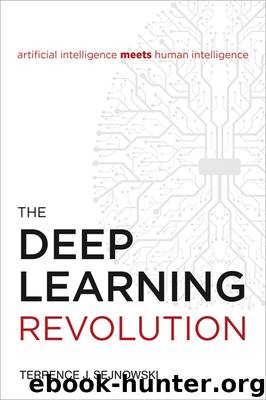The Deep Learning Revolution by Terrence Sejnowski

Author:Terrence Sejnowski
Language: eng
Format: epub
Tags: Machine learning; neural networks; artificial intelligence; human intelligence; neuroscience; reinforcement learning; learning; backpropagation; Boltzmann machines; AlphaGo; Google translate; Geoff Hinton; John Hopfield; big data; NIPS
Publisher: MIT Press
Published: 2018-09-19T16:00:00+00:00
Box 10.1
Temporal Difference Learning
In this model of the honeybee brain, actions are chosen (such as landing on a flower) that maximize all future discounted rewards:
R(t) = rt+1 + γ rt+2 + γ2 rt+3 + …,
where rt+1 is the reward at time t+1 and 0 < γ < 1 is a discount factor. The predicted future reward based on current sensory inputs s(t) is computed by neuron P:
Pt (s) = wY sY + wB sB,
where the sensory input from yellow (Y) and blue (B) flowers are weighted by wY and wB. The reward prediction error δ(t) at time t is given by
δt = rt + γ Pt(st) – Pt(st−1),
where rt is the current reward. The change in each weight is given by:
Δ wt = α δt st−1,
where α is the learning rate. If the current reward is greater than the predicted reward, and δt is positive, the weight is increased on the sensory input that was present before the reward, but if the current reward is less than expected, and δt is negative, the weight is decreased.
Adapted from Montague, P. R., and Sejnowski, T. J., “The Predictive Brain: Temporal Coincidence and Temporal Order in Synaptic Learning Mechanisms,” figure 6A, Learning & Memory 1 (1994): 1–33.
Download
This site does not store any files on its server. We only index and link to content provided by other sites. Please contact the content providers to delete copyright contents if any and email us, we'll remove relevant links or contents immediately.
| Computer Vision & Pattern Recognition | Expert Systems |
| Intelligence & Semantics | Machine Theory |
| Natural Language Processing | Neural Networks |
Algorithms of the Intelligent Web by Haralambos Marmanis;Dmitry Babenko(16235)
Jquery UI in Action : Master the concepts Of Jquery UI: A Step By Step Approach by ANMOL GOYAL(9387)
Test-Driven Development with Java by Alan Mellor(7735)
Data Augmentation with Python by Duc Haba(7609)
Principles of Data Fabric by Sonia Mezzetta(7378)
Learn Blender Simulations the Right Way by Stephen Pearson(7294)
Microservices with Spring Boot 3 and Spring Cloud by Magnus Larsson(7137)
Hadoop in Practice by Alex Holmes(6588)
RPA Solution Architect's Handbook by Sachin Sahgal(6517)
The Infinite Retina by Robert Scoble Irena Cronin(6216)
Big Data Analysis with Python by Ivan Marin(5934)
Life 3.0: Being Human in the Age of Artificial Intelligence by Tegmark Max(5518)
Pretrain Vision and Large Language Models in Python by Emily Webber(4894)
Infrastructure as Code for Beginners by Russ McKendrick(4653)
Functional Programming in JavaScript by Mantyla Dan(4436)
WordPress Plugin Development Cookbook by Yannick Lefebvre(4382)
The Age of Surveillance Capitalism by Shoshana Zuboff(4248)
Embracing Microservices Design by Ovais Mehboob Ahmed Khan Nabil Siddiqui and Timothy Oleson(4148)
Applied Machine Learning for Healthcare and Life Sciences Using AWS by Ujjwal Ratan(4135)
